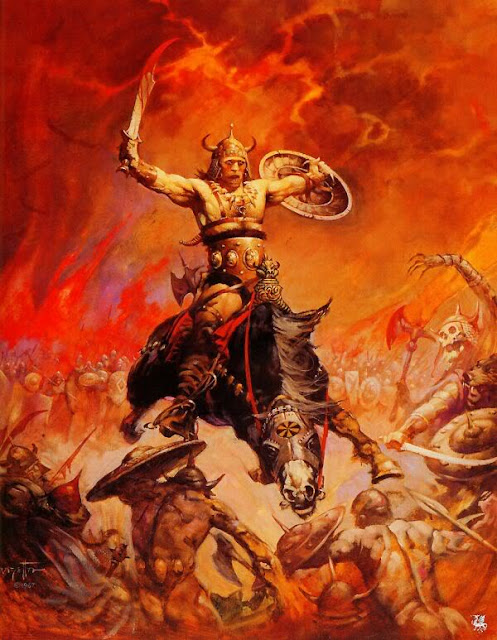Glad tidings all, and welcome back to The Art of Caesura!
While my Guinness stew is simmering away I want to follow up on something I started into last week. You may recall that last week was one big nerdgasm over my time at Warhammer World. I had so much to talk about and so many pictures to show off that I didn't have time to go into any real depth about a topic that piqued my interest during one of the Black Library talks.
Something I really took away from the discussion between Guy Haley, Nick Kyme, and Josh Reynolds was about the intended tone of AoS. I have often heard the comparison that Warhammer Fantasy was "Low" fantasy and AoS is "High" fantasy, but Guy Haley took real exception to this. He said that he sees AoS as swords and sorcery fiction. I guess I've had some subliminal idea about what people were talking about with their highs and lows, but as an English Major and life-long fantasy reader I thought it would be fun to spend today delving deeper into several fantasy subgenres as they pertain to Age of Sigmar.
So, the three subgenres of fantasy that I will focus in on today are: low fantasy, high fantasy and sword and sorcery.
Low Fantasy:
By definition, low fantasy is a story with fantasy elements that takes place in the "real" world Examples from comics are: Fables or Preacher. What really threw a spanner in my works was that it turns out that in role-playing games there's a completely different definition! Basically low fantasy in gaming terms is just less fantastical but may not take place in the "real" world. The classic example that everyone seems to use is Conan: in literary terms it's high fantasy, but in gaming terms it's low fantasy. Confused yet?
This is as good a time as any to shoe-horn in the first models that I have painted for the Conan board-game. I will talk about the game at much greater length in the future, but for now these:
These skull piles are fantastic. I think they do a brilliant job of setting tone!
High Fantasy:
Low fantasy's vis-a-vis takes place in an alternate world altogether (think Lord of the Rings here or Game of Thrones). Lynne Vallone defines high fantasy as having an "expansive or broad, panoramic setting..." and Sheila Egoff adds:
"Epic [or High] fantasy, like its forebears (myth and legend), is dominated by high purpose. There are worlds to be won or lost, and the protagonists engage in a deeply personal and almost religious battle for the common good."
So yes, by definition AoS is high fantasy, but then so was Warhammer. But what about what Guy Haley was saying about Sword and Sorcery fantasy?
Sword and Sorcery:
In tone, this is right in between Low and High fantasy. It has supernatural and magical elements but unlike high fantasy, it focuses more on personal battles rather than world-altering events. So to continue to use the same example, Robert E. Howard's Conan was the original archetype of Sword and Sorcery! Characterized by fast-paced actiony stories set in a semi-mythical realm. I would argue that Patrick Rothfuss's exceedingly excellent Kingkiller Chronicles fit into this genre.
So where does that leave us with Age of Sigmar? Well it's not low fantasy, (but then neither really was Warhammer Fantasy). It strikes me as veering more towards High Fantasy than Sword and Sorcery, but perhaps Haley was talking about the tone of things he is currently working on. He and Reynolds agreed that there has been a shift in their current works (which will come out at the end of next year) far more towards depth as opposed to breadth. We'll finally get to know what the average bum living in the mortal realms is like and what the day-to-day entails. We will also (***SPOILER ALERT***) be seeing a real Stormcast Eternal funeral in the Gardens of Nurgle. So interesting stuff ahead.
One final consideration, is that there was one display in the events centre that got me thinking about Guy Haley's interpretation of AoS, and that was the Fortress of Nurgle
Well I hope you enjoyed that frolic through generic conventions.
I'll see you next week, same bat time, same bat channel on The Art of Caesura!
Watching: Fargo Season 2
Drinking: My Great Redeemer Ale
Gaming: Just beat the new Doom
Next Week:
The leg bone's connected to the hip bone...
While my Guinness stew is simmering away I want to follow up on something I started into last week. You may recall that last week was one big nerdgasm over my time at Warhammer World. I had so much to talk about and so many pictures to show off that I didn't have time to go into any real depth about a topic that piqued my interest during one of the Black Library talks.
Something I really took away from the discussion between Guy Haley, Nick Kyme, and Josh Reynolds was about the intended tone of AoS. I have often heard the comparison that Warhammer Fantasy was "Low" fantasy and AoS is "High" fantasy, but Guy Haley took real exception to this. He said that he sees AoS as swords and sorcery fiction. I guess I've had some subliminal idea about what people were talking about with their highs and lows, but as an English Major and life-long fantasy reader I thought it would be fun to spend today delving deeper into several fantasy subgenres as they pertain to Age of Sigmar.
So, the three subgenres of fantasy that I will focus in on today are: low fantasy, high fantasy and sword and sorcery.
Low Fantasy:
By definition, low fantasy is a story with fantasy elements that takes place in the "real" world Examples from comics are: Fables or Preacher. What really threw a spanner in my works was that it turns out that in role-playing games there's a completely different definition! Basically low fantasy in gaming terms is just less fantastical but may not take place in the "real" world. The classic example that everyone seems to use is Conan: in literary terms it's high fantasy, but in gaming terms it's low fantasy. Confused yet?
 |
| Clearly, I do not own this image |
These skull piles are fantastic. I think they do a brilliant job of setting tone!
High Fantasy:
Low fantasy's vis-a-vis takes place in an alternate world altogether (think Lord of the Rings here or Game of Thrones). Lynne Vallone defines high fantasy as having an "expansive or broad, panoramic setting..." and Sheila Egoff adds:
"Epic [or High] fantasy, like its forebears (myth and legend), is dominated by high purpose. There are worlds to be won or lost, and the protagonists engage in a deeply personal and almost religious battle for the common good."
So yes, by definition AoS is high fantasy, but then so was Warhammer. But what about what Guy Haley was saying about Sword and Sorcery fantasy?
Sword and Sorcery:
In tone, this is right in between Low and High fantasy. It has supernatural and magical elements but unlike high fantasy, it focuses more on personal battles rather than world-altering events. So to continue to use the same example, Robert E. Howard's Conan was the original archetype of Sword and Sorcery! Characterized by fast-paced actiony stories set in a semi-mythical realm. I would argue that Patrick Rothfuss's exceedingly excellent Kingkiller Chronicles fit into this genre.
So where does that leave us with Age of Sigmar? Well it's not low fantasy, (but then neither really was Warhammer Fantasy). It strikes me as veering more towards High Fantasy than Sword and Sorcery, but perhaps Haley was talking about the tone of things he is currently working on. He and Reynolds agreed that there has been a shift in their current works (which will come out at the end of next year) far more towards depth as opposed to breadth. We'll finally get to know what the average bum living in the mortal realms is like and what the day-to-day entails. We will also (***SPOILER ALERT***) be seeing a real Stormcast Eternal funeral in the Gardens of Nurgle. So interesting stuff ahead.
One final consideration, is that there was one display in the events centre that got me thinking about Guy Haley's interpretation of AoS, and that was the Fortress of Nurgle
Well I hope you enjoyed that frolic through generic conventions.
I'll see you next week, same bat time, same bat channel on The Art of Caesura!
Watching: Fargo Season 2
Drinking: My Great Redeemer Ale
Gaming: Just beat the new Doom
Next Week:
The leg bone's connected to the hip bone...



Comments
Post a Comment
Tell me all...